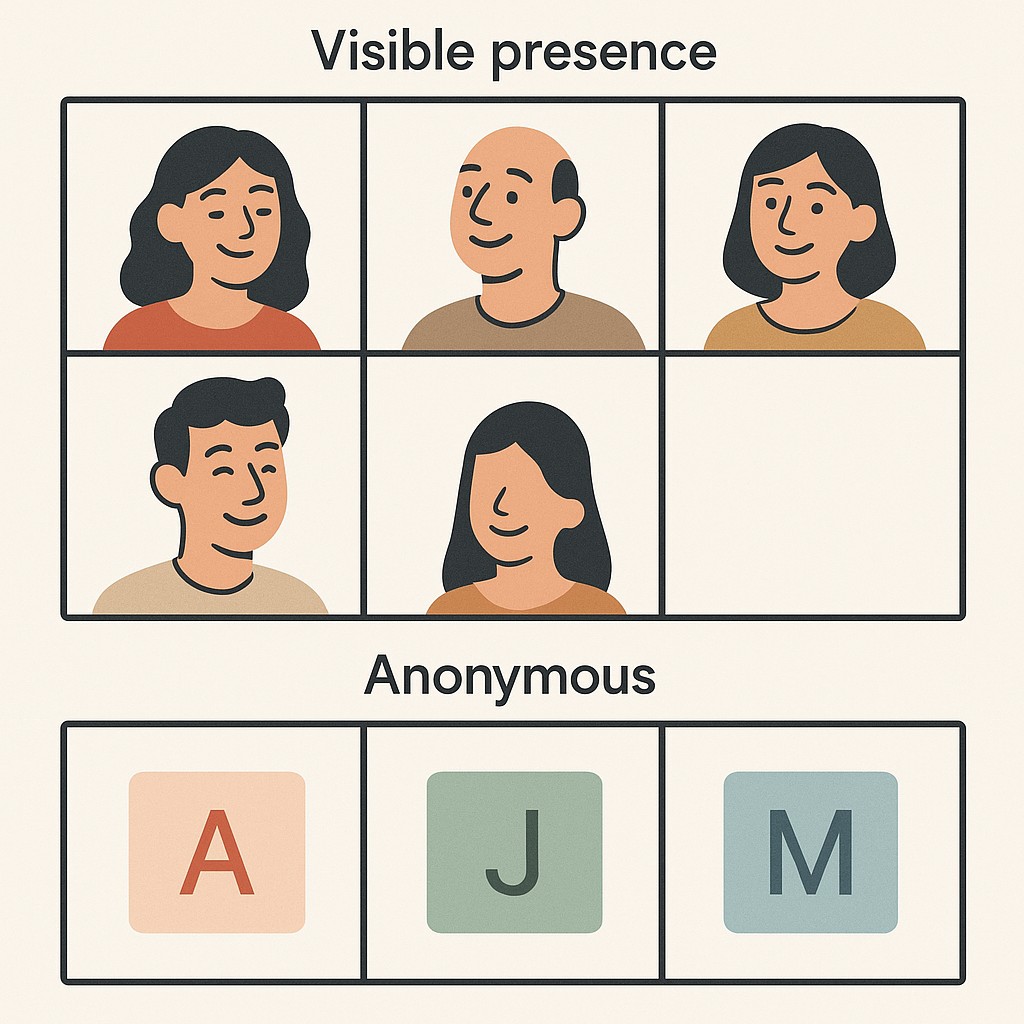Inclusive Facilitation for Remote Teams: Presence, Trust, and Better Decisions
Inclusive Facilitation for Remote Teams: Presence, Trust, and Better Decisions

Presence Changed the Room
Three years ago, I watched a team drift through remote meetings, showing up mostly out of obligation. Rituals were in place—weekly standups, retros, even the occasional “fun” icebreaker—but it still felt like we were only going through the motions. Then, almost by accident, we changed one thing: we asked everyone to turn on their cameras by default. The next few meetings felt oddly different. Faces instead of floating initials. Nod, shrug, slight smile—suddenly, the room was less flat.

Here’s what actually shifted. Through inclusive facilitation for remote teams, visible presence led to real connection, that connection built trust, and trust unlocked contribution. It wasn’t just about getting more people to talk. It was about uncovering the actual thinking in the room.
Back when we started experimenting, I’ll admit I was skeptical. Remote meetings always felt like they belonged in the same bucket as waiting rooms: people milling around, half paying attention, hoping someone else would get things moving. That changed when presence became visible.
The deeper problem with remote meetings has never been tools or time zones. It’s that dominant voices and fast thinkers end up steering outcomes, while quieter or slower processors watch from the sidelines, letting solid ideas slip by unspoken. It turns out, teams hit a higher gear when speaking time is balanced over the full session—performance follows the airtime spread, not just who talks loudest. Most remote meetings—maybe most meetings, period—are set up to do the opposite.
If you want inclusive remote collaboration to actually work, you have to design it to equalize participation and slowly build trust. That’s what I want to show you here—practical, tested ways to run engineering meetings where everyone gets a real seat at the table.
Design for Contribution, Not Control
Let’s get one thing straight. The point of cameras on and structured turns isn’t about policing or micromanaging. It’s about presence. When you show up and let yourself be seen, it’s easier for others to tune in and actually read the room. That’s not control; that’s choosing to participate.
What I’ve learned after thousands of remote meetings is simple. Remote collaboration, if left on autopilot, breeds uneven participation. Dominant voices fill the space, quieter ones fade out, and we end up working from unexamined defaults. The platform tilts the field—who speaks up shifts by gender and level—women chime in via chat more, men take the mic more often, so our design has to account for those levers. If you’re not deliberate, you won’t hear from everyone.
Think of presence like network latency. Lower the lag and suddenly feedback loops get tighter, conversations feel more natural, and ideas move fast. We keep steady contact—daily standups, weekly check-ins—not because every update is monumental, but because a rhythm of showing up builds a baseline of trust. It’s the micro-interactions, the small check-ins, that make it normal to share and take risks, even on the quiet days.
Here’s the kicker: who talks when ends up shaping technical direction more than almost anything else. Designing meetings with balanced participation strategies and knowing when to hold back as a leader is crucial—and I’d be lying if I said I’ve always gotten that right. If you catch yourself dominating airtime, you’re not alone. I’ve had to catch myself here too. We’ll set the stage for actual balance, not just token input.
Turn Input Into Action: The Operating System
Default meeting habits produce default voices—fast talkers, people confident with little context, the usual suspects. If you want genuinely broad input in your remote team, flip the format. Put the real problem and any background in front of the group ahead of time, not in the first five minutes of the call. That simple move means more brains primed and ready, not just the ones who think on their feet. Inclusive remote team meetings stop being a live brainstorm lottery. They become about mapping tradeoffs, drawing connections, and making the call. You’ll start hearing from people who normally hold back, because you gave them time to show up with substance.
Before you ever get on a call, set up inclusive remote engineering meetings by sending out the agenda, the hard constraints, and whatever docs or code need review. Drop a direct prompt inviting comments in-line. Don’t be afraid to tag teammates who tend to keep a lower profile. If you give deep thinkers a head start, you’ll get richer contributions without having to fish for them live.
In the meeting itself, you have to make space on purpose. I rotate who speaks first, just so it’s not always the same three people setting the temperature. Quick round-robins—each person answers or adds a note—pull quieter folks into the mix without putting them on the spot. Sometimes, a one-minute silent brainstorm in chat loosens ideas from the usual bottlenecks. You’d be surprised what pops up when nobody actually has the floor.
Timeboxing discussion helps too. If someone starts looping or rerunning points, the clock nudges us back to the heart of the matter, sharing airtime so no group dominates. Make sure to close with a concrete decision and a clear owner. Otherwise the equal airtime won’t stick. If you only reward quick talkers, you’ll miss your deep thinkers, and the same half-baked solution will keep circling back.
Habits aren’t built in group settings alone. In my 1:1s, I ask high-talkers to pause and practice inviting others in—even if it feels awkward at first. Quieter folks sometimes just need an entry point—a simple “I’d like to add,” or “Building on…” makes speaking up feel less like interrupting. I still catch myself jumping in sometimes. Leaders have to model patience with the urge to fill silence.
This part always reminds me of when I used to play in a band as a teenager. We rehearsed in a cramped garage, and everyone kept turning up their amp trying to be heard. Every one of us was convinced the best fix for muddiness was a little more volume. But really, all we did was make the whole thing noisy and disconnected. It’s strangely similar in meetings. Louder doesn’t add value; better listening does. I wish that lesson landed faster, both in music and in work.
And cancel meetings—seriously—if there’s nothing new to decide. If you realize the slot can be handled with an async update or a shared thread, pull the plug early. Not every day needs live airtime.
Make video-on the default for your daily standups, especially with distributed time zones. When faces are familiar, remote team trust builds—a raised eyebrow in Berlin means as much as a nod in Toronto. Keep standups quick and steady. When showing up is effortless, presence becomes the norm, not a burden.
Correct Imbalance With Coaching and Simple Tracking
It’s easy to think participation is balanced as long as it feels like “everyone chimed in.” The reality, though, is that a few voices often dominate without us noticing—especially in remote calls. I started tracking air time using a simple checklist. Who spoke, for how long, and through which channel. Some tools spit out heatmaps, but you can make this work with a spreadsheet and a pen. Note who pipes up live, who prefers async, and who consistently stays quiet. Keep everything lightweight. No need for a weekly report out. Just glancing through at patterns is enough. Over a few sprints, you’ll see who blends in and who leads the pack, and that’s when you can actually course-correct.
It’s tempting as a leader to frame every conversation from the jump, but I’ve learned the hard way. If I speak first, I set the boundaries for everyone else. In 1:1s, I ask people who dominate the conversation to hit pause, inviting others to get a word in, while for the quieter teammates, I offer them an easy scaffold—like adding thoughts at the top of the agenda or jumping in first on smaller topics. I have to catch myself, too. Leaders can steer the entire conversation just by how we open.
Remember those daily standups from earlier? They’re not about getting perfect updates or full consensus every time. It’s the rhythm that matters. Show up for daily standups and regular 1:1s, even when it starts to feel routine. Trust doesn’t grow overnight. It’s the ongoing presence and micro-interactions day after day, week after week, that build enough safety for real input to surface. And every cycle of healthy exchange is what makes broader contribution actually stick.
From Doubts to Daily Habits: Rolling Out Inclusive Facilitation for Remote Teams
Let’s clear up the two big objections up front. “Isn’t this going to eat into our valuable build time?” and “Doesn’t all this video-on and round-robin stuff feel like policing?” It’s a fair pushback. But here’s the reality—what drives real participation is a sense of safety for interpersonal risk. When the team feels safe, even hard topics get surfaced—the definition of psychological safety. Presence norms aren’t about controlling the team. They’re about giving everyone room to show up, say what needs saying, and shape stronger technical decisions. Connection isn’t just social glue or overhead. It’s your risk reduction strategy, and it’s how you build trust into every sprint.
Here’s how I’d actually roll this out, chunk by chunk. In Week 1, get buy-in for daily standups where video is on and keep the agenda tight, so showing up feels purposeful. By Week 2, start prepping with async pre-reads—circulate docs or problem frames in advance so everyone has a chance to process before discussion. Week 3 adds inclusive live habits—run round-robin updates so airtime rotates, and insert a short silent brainstorm (I usually do this right in chat) to surface ideas without interruption. By Week 4, you’re ready to track participation.
Note who builds in async vs live, who goes quiet, and who dominates. Use one-on-ones to coach folks on balancing input, and seriously, cancel any meetings that turn out low-value once you start seeing the data. Take the rollout slow—these habits need steady repetition to stick.
Engineers and AI builders, save time on docs, updates, and retros—generate AI-powered content that fits your goals, constraints, and tone, so you share clearly and ship communication fast.
I still wrestle with one thing. Even after years leading these habits, there are always voices that resist presence or never quite feel comfortable speaking up—sometimes that’s just how teams are wired, and I’m not certain there’s a perfect fix for it yet.
To check if you’re really shifting the needle, set up a loop. Monitor decision quality, cycle time, and incident postmortems for broader attribution. I review participation heatmaps once a month—just a simple scan for airtime spread and channel mix—and tweak facilitation if the pattern’s off. The metrics keep you honest. The loop keeps you improving.
Design for presence and inclusion with inclusive facilitation for remote teams, stick to the rhythm, and you’ll surface more ideas, uncover real risks, and end up making better bets—every cycle.
Enjoyed this post? For more insights on engineering leadership, mindful productivity, and navigating the modern workday, follow me on LinkedIn to stay inspired and join the conversation.
You can also view and comment on the original post here .
